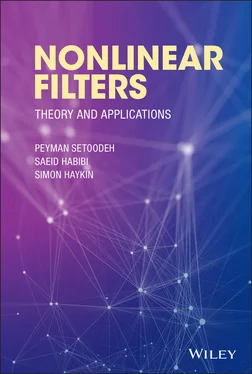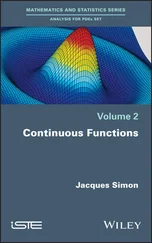Simon Haykin - Nonlinear Filters
Здесь есть возможность читать онлайн «Simon Haykin - Nonlinear Filters» — ознакомительный отрывок электронной книги совершенно бесплатно, а после прочтения отрывка купить полную версию. В некоторых случаях можно слушать аудио, скачать через торрент в формате fb2 и присутствует краткое содержание. Жанр: unrecognised, на английском языке. Описание произведения, (предисловие) а так же отзывы посетителей доступны на портале библиотеки ЛибКат.
- Название:Nonlinear Filters
- Автор:
- Жанр:
- Год:неизвестен
- ISBN:нет данных
- Рейтинг книги:5 / 5. Голосов: 1
-
Избранное:Добавить в избранное
- Отзывы:
-
Ваша оценка:
- 100
- 1
- 2
- 3
- 4
- 5
Nonlinear Filters: краткое содержание, описание и аннотация
Предлагаем к чтению аннотацию, описание, краткое содержание или предисловие (зависит от того, что написал сам автор книги «Nonlinear Filters»). Если вы не нашли необходимую информацию о книге — напишите в комментариях, мы постараемся отыскать её.
Discover the utility of using deep learning and (deep) reinforcement learning in deriving filtering algorithms with this insightful and powerful new resource Nonlinear Filters: Theory and Applications
Nonlinear Filters
Nonlinear Filters: Theory and Applications
Nonlinear Filters — читать онлайн ознакомительный отрывок
Ниже представлен текст книги, разбитый по страницам. Система сохранения места последней прочитанной страницы, позволяет с удобством читать онлайн бесплатно книгу «Nonlinear Filters», без необходимости каждый раз заново искать на чём Вы остановились. Поставьте закладку, и сможете в любой момент перейти на страницу, на которой закончили чтение.
Интервал:
Закладка:
165 159
166 160
167 161
168 162
169 163
170 164
171 165
172 166
173 167
174 168
175 169
176 170
177 171
178 172
179 173
180 174
181 175
182 176
183 177
184 178
185 179
186 180
187 181
188 182
189 183
190 185
191 186
192 187
193 188
194 189
195 190
196 191
197 192
198 193
199 194
200 195
201 196
202 197
203 198
204 199
205 200
206 201
207 203
208 204
209 205
210 206
211 207
212 208
213 209
214 210
215 211
216 213
217 214
218 215
219 216
220 217
221 218
222 219
223 220
224 221
225 222
226 223
227 224
228 225
229 226
230 227
231 228
232 229
233 230
234 231
235 232
236 233
237 234
238 235
239 236
240 237
241 238
242 239
243 240
244 241
245 242
246 243
247 244
248 245
249 246
250 247
251 248
252 249
253 250
254 251
255 253
256 254
257 255
258 256
259 257
260 258
261 259
262 260
263 261
264 262
265 263
266 264
267 265
268 266
269 267
270 268
271 269
272 270
273 271
274 272
275 273
276 274
Nonlinear Filters
Theory and Applications
Peyman Setoodeh
McMaster University
Ontario, Canada
Saeid Habibi
McMaster University
Ontario, Canada
Simon Haykin
McMaster University
Ontario, Canada

This edition first published 2022 © 2022 by John Wiley & Sons, Inc.
All rights reserved. No part of this publication may be reproduced, stored in a retrieval system, or transmitted, in any form or by any means, electronic, mechanical, photocopying, recording or otherwise, except as permitted by law. Advice on how to obtain permission to reuse material from this title is available at http://www.wiley.com/go/permissions.
The right of Peyman Setoodeh, Saeid Habibi, and Simon Haykin to be identified as the authors of this work has been asserted in accordance with law.
Registered Office John Wiley & Sons, Inc., 111 River Street, Hoboken, NJ 07030, USA
Editorial Office 111 River Street, Hoboken, NJ 07030, USA
For details of our global editorial offices, customer services, and more information about Wiley products visit us at www.wiley.com.
Wiley also publishes its books in a variety of electronic formats and by print‐on‐demand. Some content that appears in standard print versions of this book may not be available in other formats.
Limit of Liability/Disclaimer of Warranty The contents of this work are intended to further general scientific research, understanding, and discussion only and are not intended and should not be relied upon as recommending or promoting scientific method, diagnosis, or treatment by physicians for any particular patient. In view of ongoing research, equipment modifications, changes in governmental regulations, and the constant flow of information relating to the use of medicines, equipment, and devices, the reader is urged to review and evaluate the information provided in the package insert or instructions for each medicine, equipment, or device for, among other things, any changes in the instructions or indication of usage and for added warnings and precautions. While the publisher and authors have used their best efforts in preparing this work, they make no representations or warranties with respect to the accuracy or completeness of the contents of this work and specifically disclaim all warranties, including without limitation any implied warranties of merchantability or fitness for a particular purpose. No warranty may be created or extended by sales representatives, written sales materials or promotional statements for this work. The fact that an organization, website, or product is referred to in this work as a citation and/or potential source of further information does not mean that the publisher and authors endorse the information or services the organization, website, or product may provide or recommendations it may make. This work is sold with the understanding that the publisher is not engaged in rendering professional services. The advice and strategies contained herein may not be suitable for your situation. You should consult with a specialist where appropriate. Further, readers should be aware that websites listed in this work may have changed or disappeared between when this work was written and when it is read. Neither the publisher nor authors shall be liable for any loss of profit or any other commercial damages, including but not limited to special, incidental, consequential, or other damages.
Library of Congress Cataloging‐in‐Publication Data Applied for: ISBN: 9781118835814
Cover Design: Wiley
Cover Image: © Emrah Turudu/Getty Images
To the memory of RudolfEmil Kalman
Preface
Taking an algorithmic approach, this book provides a step towards bridging the gap between control theory, statistical signal processing, and machine learning regarding the state/parameter estimation problem. State estimation is an important concept that has profoundly influenced different branches of science and engineering. State of a system refers to a minimal record of the past history, which is required for predicting the future behavior. In this regard, a dynamic system can be described from the state perspective by selecting a set of independent variables as state variables. It is often desirable to know the state variables, and in control applications, to force them to follow desired trajectories in the state space. State estimation refers to the process of reconstructing the hidden or latent state variables, which cannot be directly measured, from system inputs and outputs in the minimum possible length of time. Filtering algorithms, which are deployed for state estimation, aim at minimizing the error between the estimated and the true values of the state variables.
The first part of the book is dedicated to classic estimation algorithms. A thorough presentation of the notion of observability, which refers to the ability to reconstruct the state variables from measurements, is followed by covering a number of observers as state estimators for deterministic systems. Regarding stochastic systems, optimal Bayesian filtering is presented that provides a conceptual solution for the general state estimation problem. Different Bayesian filtering algorithms have been developed based on computationally tractable approximations of the conceptual Bayesian solution. For the special case of linear systems with Gaussian noise, Kalman filter provides the optimal Bayesian solution. To extend the application of Kalman filter to nonlinear systems, two main approaches have been proposed to provide suboptimal solutions: using power series to approximate the nonlinear functions and approximating the probability distributions. While extended Kalman filter, extended information filter, and divided‐difference filter approximate the nonlinear functions, unscented Kalman filter, cubature Kalman filter, and particle filter approximate the probability distributions. Other Kalman filter variants include Gaussian‐sum filter, which handles non‐Gaussianity, and generalized PID filter. Among the mentioned filters, particle filter is capable of handling nonlinear and non‐Gaussian systems. Smooth variable‐structure filter, which has been derived based on a stability theorem, is able to handle model uncertainties. Moreover, it benefits from using a secondary set of performance indicators in addition to the innovation vector.
Читать дальшеИнтервал:
Закладка:
Похожие книги на «Nonlinear Filters»
Представляем Вашему вниманию похожие книги на «Nonlinear Filters» списком для выбора. Мы отобрали схожую по названию и смыслу литературу в надежде предоставить читателям больше вариантов отыскать новые, интересные, ещё непрочитанные произведения.
Обсуждение, отзывы о книге «Nonlinear Filters» и просто собственные мнения читателей. Оставьте ваши комментарии, напишите, что Вы думаете о произведении, его смысле или главных героях. Укажите что конкретно понравилось, а что нет, и почему Вы так считаете.












